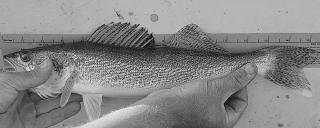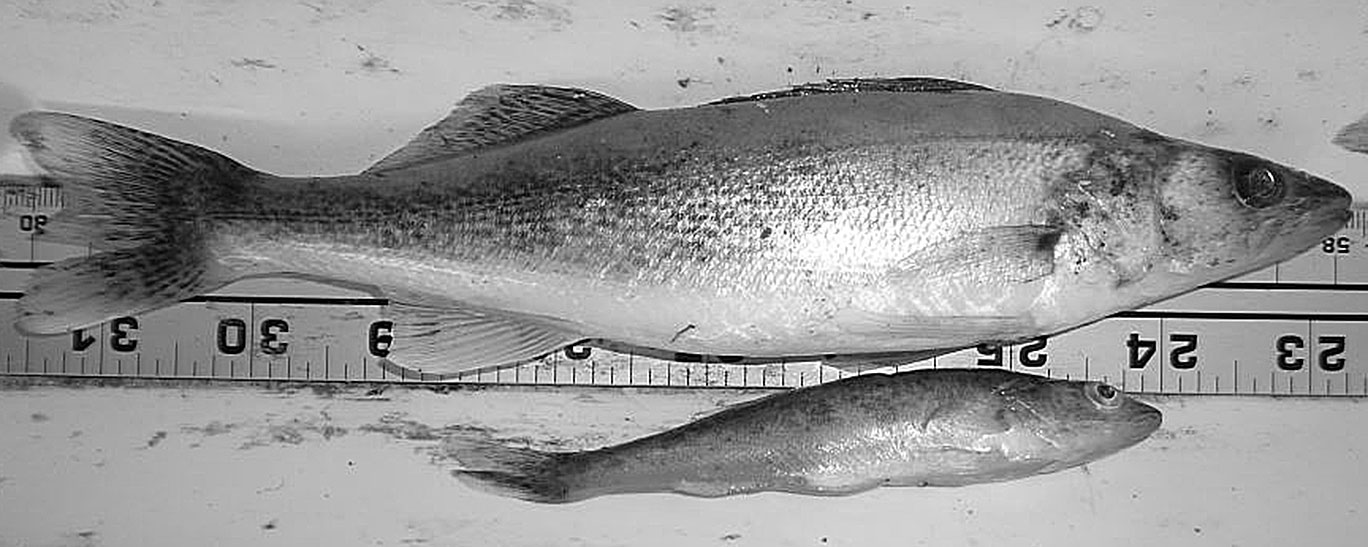
Walleye Regulation Fact Sheets
Walleye populations vary dramatically throughout North America and thus management practices (including regulations) also differ significantly between states/provinces and within states/provinces. Collection, analysis and interpretation of biological data (via research, sampling surveys, etc.) drives management decisions as how to best manage any given fishery.
The information below addresses how the Department determines length restrictions on walleye fisheries.
Assessing a Minimum Length Walleye Restriction | Assessing a "One-Over" Walleye Length Restriction
Assessing a Minimum Length Walleye Restriction
Ample water and aggressive fish stocking produced numerous “new” walleye fisheries across North Dakota in the past two decades. These new lakes are productive, and have provided fantastic fishing opportunities.
With an increase in walleye anglers, concerns by some regarding the potential for overharvest, and requests for special regulations to curtail harvest, are more common. On many new waters, a minimum length limit to allow small fish to grow before being harvested is the most often-requested regulation.
North Dakota Game and Fish Department biologists responsible for stocking, managing and developing these new waters are monitoring their progress since before the first walleye were stocked. They gather information on lake water quality, forage abundance, walleye growth, survival, stocking success, and in some instances angler use and preferences. This collection of information allows biologists to determine stocking rates and evaluate whether any special regulations would improve the walleye populations, either biologically through improved growth or survival, or perceptually by providing a size structure anglers find more desirable.
Biological
Biologically, a minimum length limit would benefit a walleye population that meets four specific criteria:
- population exhibits low reproductive or stocking success,
- fish exhibit good growth,
- it’s subject to high fishing mortality, and
- natural mortality is low.
If all criteria aren’t met, a minimum size limit would not improve the population. Alternately, if a minimum size limit is applied to a population with abundant small fish that are slow growing, protecting them from harvest would create a stockpiling effect that may result in a stunted population. Also, if natural mortality is high, protected fish would die of natural causes before reaching a desirable size.
We seldom see poor stocking success that would require protection of smaller fish on most North Dakota waters. Especially on newer lakes, we have established good year-classes through stocking. In most cases where we see a shortage of small fish, it’s the result of other factors, such as predation or lack of forage. So, the first requirement for a successful minimum length limit is seldom met.
On traditional lakes and reservoirs across North Dakota, walleye growth tends to be good, satisfying the second requirement. On new lakes, above average growth is common. Most new waters are targeted for stocking because biologists have noted an abundance of fathead minnows. Newly stocked walleye survive and grow fast on this abundant forage, commonly reaching 14-15 inches after only two summers. During this developmental period, a minimum length limit is unnecessary for two reasons. First, when forage is abundant, fish are generally hard to catch and little harvest of small fish occurs. Second, fish grow so rapidly they quickly outgrow the small size range.
High fishing mortality is the most necessary criteria to meet for any harvest regulation. If anglers aren’t having an impact on the population, there’s no need to restrict harvest, and doing so will do nothing to improve the population.
Biologists use fish population information to monitor total mortality, which combines both fishing mortality and natural mortality. As long as total mortality is in a sustainable range, we can be certain that neither fishing nor natural mortality are excessive. Natural mortality is usually low in most new walleye lakes where forage is abundant. Similarly, when forage is abundant and fish are hard to catch, fishing mortality can be low, too. When forage declines and a good bite occurs, anglers will harvest a substantial number of walleye and fishing mortality can be high for a period. In cases like this, high fishing mortality is necessary to reduce the population size and bring it into balance with the forage base.
Marvin Miller Lake in Logan County is a good example, where it took 10 years of aggressive stocking before the forage base declined. When that happened, fishing was outstanding for a time, to the point that anglers became concerned that harvest was too high. However, netting data from Marvin Miller at the time showed the forage was still low, and individual fish were skinny. When forage is low, the alternative to high fishing mortality would be high natural mortality, as fish begin to starve. We’d much rather see those walleye go home with anglers than die of starvation.
When we evaluate the biology of our new walleye fisheries, as outlined above, harvest of small fish isn’t limiting the quality of fishing in any of the waters. We find that most cases do not meet the criteria for a special regulation, and that minimum length limits would not have much success at enhancing fishing in those lakes.
Social
Some anglers, including those familiar with the biology of these lakes, maintain that a minimum length limit should be implemented because it’s their belief that small fish should be allowed to get bigger. This is purely a social viewpoint of fishing regulations, because implementing a length limit without biological support would not create any detectable change in what anglers catch. Although some anglers do harvest small fish, to implement a minimum length limit where it isn’t needed, particularly where it wouldn’t improve the population, is simply imposing some anglers’ personal beliefs on other anglers. Moreover, doing so gives anglers the false impression that the regulation is in place because it’s enhancing the population, when in fact it isn’t.
Conclusion
The Department’s philosophy is to implement regulations when/where they have a reasonable chance of improving the population for anglers, and to make those decisions based on the science and biology of the fishery. Statewide minimum length limits would certainly be inappropriate, considering the varying conditions on walleye fisheries across North Dakota. Minimum length limits are considered on a per-lake or regional basis, and implemented when evidence suggests a walleye population, and ultimately anglers, can benefit from having the regulation in place.

Assessing a "One-Over" Walleye Length Restriction
Many anglers wonder if fish size restrictions would make fishing better on their favorite water. The most common suggestion is either a water-specific or statewide one-over regulation, allowing anglers to keep one walleye over a certain length in their daily limit.
Game and Fish Department fisheries biologists have made a concerted effort the past few years to review all possible length regulation restrictions, and routinely reassess when conditions change. From the extra effort to conduct these evaluations, biologists have not found any instances where data supports a length restriction to improve existing walleye populations.
And yet, some anglers still suggest that additional conservation measures are needed because too many large walleye are being harvested, particularly on Devils Lake and the Missouri River. Some of these anglers request that larger fish be protected to enhance the opportunity for themselves and others to catch large fish. Although not a biological reason for the well-being of the population, this social aspect is also considered when setting regulations.
Biological
From a biological standpoint, maximum length limits (one-over is a derivative of a maximum length limit) are likely to benefit fisheries where fish reproduction is limited by the number of brood fish, and angling mortality of large fish is high. Therefore, a one-over regulation might help in a lake where angling exploitation is reducing the number of spawning-age fish, and inhibiting natural reproduction.
In North Dakota, the Missouri River/ Lake Oahe is the only walleye population that relies entirely on natural reproduction, while at Devils Lake both natural reproduction and stocking contribute to the population. While other waters, including Lake Sakakawea, do experience natural reproduction, all are supplemented or maintained through stocking.
A typical walleye population can sustain total mortality rates up to 40-55 percent, according to scientific literature from across North America. Rates above 55 percent become problematic.
Total mortality rates on the Lake Oahe, Devils Lake and Lake Sakakawea have ranged from 31-36 percent in recent years. On the Missouri River in 2015, total mortality was higher at 51 percent, but still within the sustainable range. A large portion of the mortality since 2012 was due to natural causes from the lack of forage after the 2011 flood, and not from angler harvest.
Since mortality is not excessively high, it’s also not surprising that reproduction has not been affected. Anglers have expressed concern over the harvest of large pre-spawn walleye from Devils Lake’s tributary coulees every spring. The spring of 2009 stands out because flows were high and fishing was very good in the coulees that spring. That same year, Game and Fish biologists recorded the highest walleye reproduction ever documented on Devils Lake, without stocking any walleyes in the lake in 2009. This strongly indicates that natural reproduction is a significant contributor to the walleye population, even with the spring harvest.
Similarly, the Missouri River and Lake Oahe have not been stocked with walleye since 1981, despite traditionally good pre-spawn fishing every spring.
Social
Beyond biological considerations, some anglers feel a one-over length limit will extend the big fish resource, allowing anglers to catch big fish again later. Tagging studies on North Dakota walleye populations have shown that typically less than one of every five walleye released is caught again.
Biologists have evaluated the potential effectiveness of a possible one walleye over 20 inches regulation on various waters using creel survey data collected since 2009. The most recent 2018 creel survey on the Missouri River and Lake Oahe revealed that if a one-over 20 inch regulation had been in place, it would have required the release of just 14 of the 1,157 fish measured.
Lake Sakakawea currently has a walleye population with a much higher proportion of 20-inch-plus walleye than the Missouri River and Lake Oahe. From June 1 through August 15, 2018, creel clerks measured nearly 10,000 walleye harvested by anglers, and only 276 would have been released if a one-over 20 inch regulation had been in place.
Surveys commonly show that anglers tend to voluntarily release fish over 20 inches. For example, on Devils Lake from 2013-2019, the proportion of 20 inch and larger walleye in the population survey averaged 6.6 percent of the population, while the proportion of fish of the same size harvested by anglers over the same time period averaged only 3.4 percent.
Conclusion
Size limits to restrict the harvest of fish simply don’t work when anglers aren’t having a major impact on the population to begin with. Game and Fish is fortunate to have sufficient long-term information to help effectively manage the state’s fisheries. At current fishing effort and exploitation rates, Game and Fish biologists are confident that a one-over regulation would serve no biological or social purpose.
